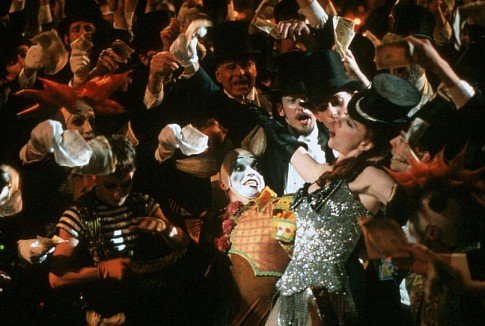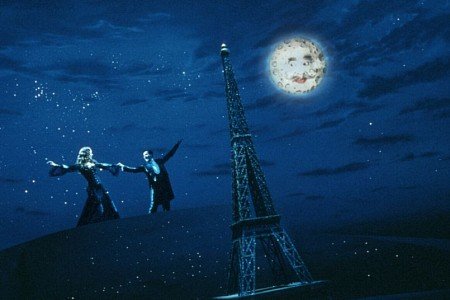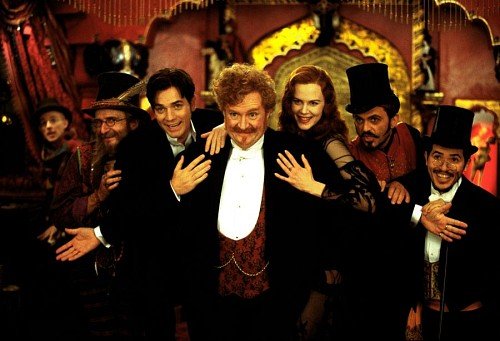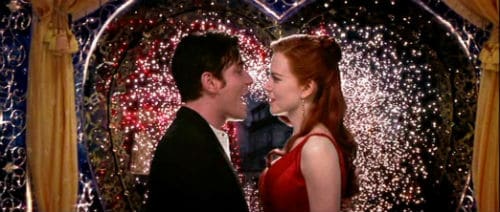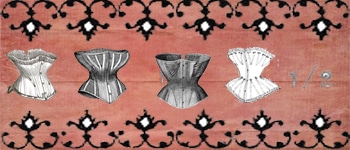Concluding the Red Curtain Trilogy is Moulin Rouge! This was actually the first Baz Luhrmann film I ever saw. In addition, it was one of the earliest romance films I remember watching as well as one of the earliest films I watched with both of my parents.
All three of us really enjoyed it and as one can imagine I have some nostalgic feelings towards this film. Over the years, I have watched the film multiple times and have gotten something new out of it each time that I see it. In my opinion, it is one of the best musicals to come out in the last fifteen years.
RELATED: All Six Spectacular Baz Luhrmann Movies Ranked: From Elvis to Moulin Rouge
The film tells a basic love story about two star-crossed individuals falling in love, Christian the penniless writer and Satine the courtesan. Christian and the other Bohemians work together to write a musical play for the Moulin Rouge which is in the process of being converted into a theater.
This can only happen if Satine can persuade and seduce their investor the Duke into giving them the funding they need. Luhrmann also pulls elements from the Greek myth Orpheus. Luhrmann knows this kind of story has been done millions of times so he does some things differently in how he tells the story. For one, it is told in three different perspectives.
The first is the perspective of the here and now, although in past tense, with the actions and decisions of the characters being made in the moment. This is the reality of the story as it unfolds. The second perspective is the one of the lavish musical being written by Christian.
Throughout the course of the film these two perspectives interact, each one affecting and influencing the other. What happens in the play helps shape and determine what happens in reality and what happens, in reality, helps determine what happens in the play. The final perspective is that of Christian sitting at his typewriter and telling us his story. Unlike the other two, this perspective cannot be influenced or changed and it bathes the film in a sense of tragedy.
The second thing Luhrmann does that is different from any other film of this kind that I have seen before or since is how he has the characters openly question the formula as it is happening to them. The film remains true to the formula but at the same time turns it on its head. The Duke is introduced deliberately with no question as to his role in the film.
He is the villain with no redeeming qualities whatsoever. But after setting this up, Luhrmann does something that goes against the rules. After establishing him as the one dimensional villain, Luhrmann gives him a voice, an opinion on that part of the formula, insight into the formula and the ability to change it.
Christian wrote the play to be a blueprint of how it will all end in reality with the Duke being defeated and Christian and Satine living happily ever after. But after the Duke realizes what the play is really about, he sees how the story is going to end and he changes it, making it so the courtesan chooses him/the maharaja who offers her a lifetime of security while the penniless setar player/writer will leave her after he has satisfied his lust.
Thus, the formula becomes a weapon that the participants in the formula use against one another. We even have the protagonist and the antagonist arguing over this formula even as they participate in it. The film builds up the audience’s expectations and dashes them in the wind. That is genius.
Another element that I adore about this film is the fantastic musical numbers. Aside from one song, all of the songs are modern, popular and were not written for the film. All of the songs were handled with care and real thought in making sure the songs fit in with the story and characters and not just randomly selected from a jukebox playlist.
I have always thought that the motivations for using modern songs was to illustrate how these songs are new and exciting for the characters in the film. They may be commonplace to us, but they are out of this world for them. The level of preparation that goes into making any musical sequence is in this film with Luhrmann making each number lavish, stunning and eye catching.
One such number is “Your Song” with amazing camera angles, colors, and glitter, so much glitter. I also like how it is carefully integrated into the plot, showing Christian’s poetic abilities. Even though the audience knows Elton John actually wrote the song, the fantasy element that surrounds Moulin Rouge! suspends the audience’s disbelief.
Another example is “El Tango de Roxanne” that builds and builds and perfectly illustrating the turmoil Christian feels about loving Satine and the knowledge in the back of his mind that she is a prostitute.
Like all of Luhrmann’s films, Moulin Rouge! is filled with fantastic visuals, sets, jump-cuts, and outlandish camera angles that I can imagine making some people feel a bit dizzy afterward. Some people who saw the film praised it for its marvelous sets but could not really enjoy them because the camera continued to move at such a frenzied pace.
Because of the editing, I have heard some people say they cannot even get past the first ten minutes of the film. I can understand why. The majority of Luhrmann’s films are like that and I can see why such a style would throw some people off. However, after the first ten minutes the editing does slow down to a much more manageable pace and stays like that throughout most of the film.
While I can understand such feelings regarding the editing, I would argue that, particularly for this film, is precisely the point. That the feverish editing is meant to create in the viewer the experience of being the protagonist and feeling what they are feeling through the visual medium that is film.
The characters are not the most original but they are still enjoyable to watch. Christian is a poet who wants nothing more than to share his heart and fall in love. He wants to live a penniless existence, writing about truth, beauty, freedom, and love, all of the values embraced by the Bohemian artists of the time period. He is wide-eyed, passionate and talented.
He sees his situation through the eyes of a child, believing that everything will work out in the end. Unlike Satine, Christian is not conflicted by his love. In his eyes it makes sense to be with Satine because he loves her and she loves him.
Satine is the star of the Moulin Rouge. She is a dancer and a prostitute. She is the most sought-after and adored worker at the Moulin Rouge. Satine is a prisoner being held in a gilded palace. She is adored by men far and wide who come to the Moulin Rouge and spend ludicrous amounts of money simply to be near her. She is adorned in the finest clothing and jewels the period has to offer. She is the most beloved prostitute around but she is still a prostitute nonetheless.
Satine desires to be free from the Moulin Rouge and finally become a real actress. It is established by the people around her that she is an excellent actress and it is what she loves doing the most. It is what she is passionate about and what she wants to pursue. Satine sees her situation, both with Christian and the Duke through the eyes of an adult. She cares for Christian and her life at the Moulin Rouge, her friends and colleagues who will be out of work if she does not come through with getting the investment money from the Duke. She is conflicted by her love, torn between loving Christian and doing what is needed of her in order to take care of her life and her friends.
Harold Zidler is the owner of the Moulin Rouge and is, interestingly enough, Satine’s father figure as well as her pimp. Zidler has made the recent decision to turn the Moulin Rouge from a nightclub into a legitimate theater, which coincides nicely with Satine’s dream. The Duke is the wealthy investor who must be seduced and convinced by Satine to invest in the renovation of the Moulin Rouge.
The Duke is the obvious villain, bordering on caricature . But when he is given a voice on the play and the film’s formula, he becomes more interesting, at least to me as his predictions of the penniless writer/setar player leaving the courtesan after he has satisfied his lust are not completely wrong. Christian leaving Satine after he has satisfied his physical desires has a real plausibility. It remains to be seen what will become of their love affair after the novelty has worn off. What the Duke suggests while not certain is a real possibility.
Though their star-crossed love is typical there is still a genuine chemistry between them that makes their relationship believable. The love they feel for each other is as real as anything they have ever felt before. As the audience we get to see both the comedy and tragedy of these two characters. As their love veers toward tragedy, it gets more sad and emotional because the audience has gotten to know these two and as the story continues the final result is really heartbreaking. Even though we know it is coming due to the revelation in the beginning of the film, it is still emotionally powerful and makes the good and happy moments between these two characters all the more precious.
The fact that the love story manages to make an emotional impact is a key to the film’s success. The film is about love but it is also a story about the death of innocence, and the discovery that beauty and agony can come from the same place. These messages are depicted beautifully through Christian and Satine’s story and these messages stuck with me even long after the film stopped playing.
Moulin Rouge! may seem like a hyperkinetic, jukebox musical with a typical love story in the middle on the surface…okay it is. However, Baz Luhrmann creates an impressive experience that takes some interesting filmmaking steps in telling its story as well as adding new elements to the typical love story that I had never seen before. Its nice mix of humor, drama and heart results in what I think is a fantastic, visually stunning film that I find myself watching again and again quite often.
As a story teller you can do one of three things. You can go outside the box, you can stay inside the box or you can tilt the box. All three options have their advantages and place and none of them are the one correct answer. Personally, I love the tilt the box strategy which is why Baz Luhrmann is one of my favorite film makers.
Not because I think his films are the greatest ever made, but because he is so good with taking conventions and using them in interesting ways and The Red Curtain Trilogy is a great example of this. His films perfectly walk the line of staying with conventions and slanting them, which makes the films more interesting and enjoyable.
His films may not be perfect but they are full of glamour, glitz, music as well as vibrant, energetic, and meticulous cinematography. I look forward to any new films he has in store and what interesting turns he takes in his future works. And I hope he can continue to bring such interesting and visually memorable works for years to come.
Overall Rating:
“You had me at hello.”
Romance Rating:
“You pierce my soul. I am half agony, half hope.
I have loved none but you.”


